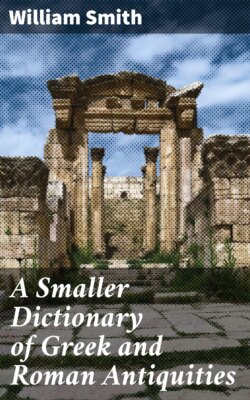Читать книгу A Smaller Dictionary of Greek and Roman Antiquities - William Smith - Страница 11
На сайте Литреса книга снята с продажи.
ОглавлениеBuccina, Trumpet. (Blanchini, De Mus. Instrum. Vet.)
BULLA, a circular plate or boss of metal, so called from its resemblance in form to a bubble floating upon water. Bright studs of this description were used to adorn the sword belt; but we most frequently read of bullae as ornaments worn by children, suspended from the neck, and especially by the sons of the noble and wealthy. Such an one is called heres bullatus by Juvenal. The bulla was usually made of thin plates of gold. The use of the bulla, like that of the praetexta, was derived from the Etruscans. It was originally worn only by the children of the patricians, but subsequently by all of free birth.
Bulla. (From the Collection of Mr. Rogers; the gold chord added from a specimen in the Brit. Mus.)
BŪRIS. [Aratrum.]
BUSTUM. It was customary among the Romans to burn the bodies of the dead before burying them. When the spot appointed for that purpose adjoined the place of sepulture, it was termed bustum; when it was separate from it, it was called ustrina. From this word the gladiators, who were hired to fight round the burning pyre of the deceased, were called bustuarii.
BUXUM or BUXUS, probably means the wood of the box-tree, but was given as a name to many things made of this wood. The tablets used for writing on, and covered with wax (tabulae ceratae), were usually made of box. In the same way the Greek πυξίον, formed from πύξος, “box-wood,” came to be applied to any tablets, whether they were made of this wood or any other substance. Tops and combs were made of box-wood, and also all wind instruments, especially the flute.
BYSSUS (βύσσος), linen, and not cotton. The word byssus appears to come from the Hebrew butz, and the Greeks probably got it through the Phoenicians.
